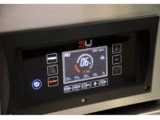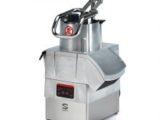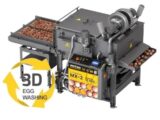Why Vacuum Pack?
by Polina
Following their European counterparts, an increasing number of American chefs, foodservice and supermarket operators are investing in vacuum packing machines to incorporate them in their daily operations.
Vacuum packing machines are a great tool to extend shelf life and to prevent freezer burn. The vacuum packer has also become an essential piece of kitchen kit for many chefs and caterers who gain specific benefits in terms of advanced food preparation, portion control, spread workload, reduced food wastage, lower food costs, safer food storage, higher standards of food hygiene and Sous Vide or water bath cooking. Freshly Squeeezed offers one of the best European vacuum packing machines manufactured by Sammic, Spain. Sammic’s vacuum packing machines are not only specifically designed for the foodservice industry they also are the only vacuum packers that are NSF certified.
Tangible advantages can be gained in the kitchen from vacuum packing and storing pre-prepared foods such as fresh or sliced meats, fish, poultry, vegetables, fruits, salads and cheeses for several days without any deterioration in quality and pre-portioning soups, sauces and entire dishes to reduce food wastage. These advantages extend to butchering, peeling and slicing in advance of busier times and batch production of meals and meal components for mise en place operations. All these benefits contribute to increasing the efficiency of the kitchen and the possibility of offering a wider choice on the menu. All food – both cooked and raw – can be hygienically stored in vacuum pouches for storage in one refrigerator or effortless transported between locations thus minimizing the risks of cross-contamination.
The Sammic vacuum packing is a method of storing and preserving food in an airless environment, usually in air-tight pouches.
Unlike normal atmospheric conditions of air pressure equating to approximately 1,000 mbar, a vacuum environment has little or no oxygen, i.e. depending on the capabilities of the vacuum packer air pressure can be reduced as low as 0.5 mbar (in other words 99% vacuum). It is well established that vacuum packed foods can keep food fresh for up three to five times longer than refrigeration.
The table below sets out some guidelines on the shelf life of vacuum packed foods when used in conjunction with refrigeration at +3/+5°C. (such as fish, meat, poultry and cheese) or in a larder (dry ambient food such as coffee, dried fruits, rice, cereal etc.).
Foodstuff |
Natural Duration (Days) |
Duration in a Vacuum(Days) |
Fresh Fish |
3 |
9 |
Fresh Fish (without insides) |
3 |
12 |
Fresh Uncooked Meat |
3 |
15 |
Chicken Meat Ready to be Cooked |
3 |
15 |
Cooked Meat |
5 |
20 |
Fresh Sausages |
2 – 3 |
5 |
Seasoned Hams |
7 |
25 |
Sliced Ham |
5 |
20 |
Fresh Soft Cheese |
7 |
20 |
Seasoned Cheese |
15 |
60 |
Cooked Dishes (e.g. Pasta, Rice) |
3 |
15 |
Coffee, Tea & Dry Powdered Foodstuffs |
180 |
365 |
Rice & Dry Pasta |
180 |
365 |
Dry Biscuits |
120 |
365 |
Bread |
2 |
10 |
Dry Food |
40 |
100 |
Dry Fruits |
180 |
365 |
Fresh Fruits |
10 |
25 |
Fresh Salad |
3 |
12 |
Fresh Vegetables |
7 |
25 |
In addition to the storage benefits of vacuum packing in the refrigerator and larder, cold frozen food stored in a vacuum pack does not suffer the affects of freezer burn.
Moreover, Sammic vacuum packing has advanced over the years and progressed from purely being a shelf life extender and portion control tool into a forward thinking cooking technique in its own right. Sous Vide or water bath cooking refers to a cooking technique in which a chef vacuum packs food with the sole purpose of poaching the pack in water at a precise temperature for a given period of time. This method is one of the most important culinary innovations of modern times and heralds in a new era of gastronomy, including new cooking times for service that keeps meat meltingly tender, fish succulent no matter how long it’s been cooked for and fruit and vegetables that retain their colour and flavor while undergoing remarkable transformations in texture, not too mention many operational benefits such as slow cooking and cook and chill for regeneration on demand.












